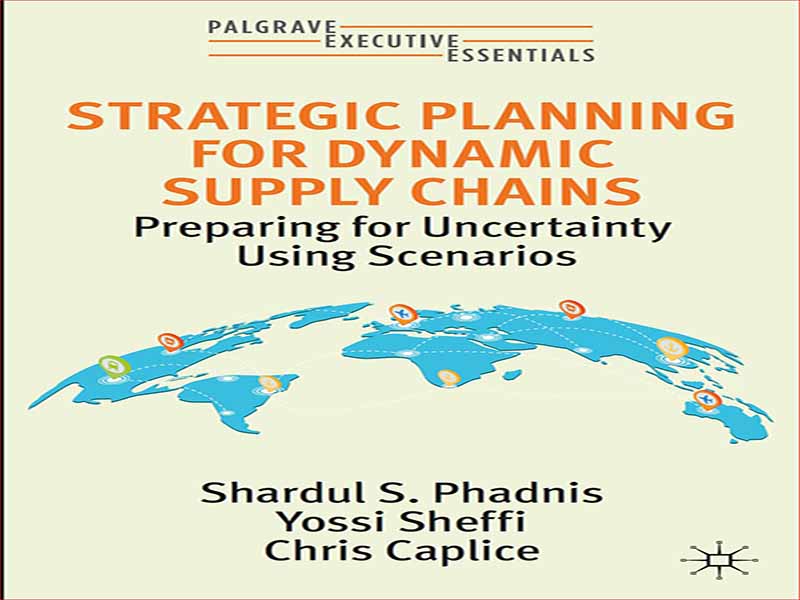- عنوان: Strategic Planning for Dynamic Supply Chains
- نویسنده: Shardul S. Phadnis
- حوزه: زنجیره تامین
- سال انتشار: 2022
- تعداد صفحه: 244
- زبان اصلی: انگلیسی
- نوع فایل: pdf
- حجم فایل: 3.50 مگابایت
تحقیقات ارائه شده در این کتاب ریشه در اوایل دهه 2000 دارد. در سال 2004، مرکز حمل و نقل و لجستیک theMIT (CTL) زنجیره تامین 2020 را راه اندازی کرد، پروژه ای برای شناسایی اصول زیربنای تعالی و آمادگی زنجیره تامین. از آنجا، پروژه گسترش یافت و شامل سؤالات اساسی در مورد ساختار استراتژی زنجیره تأمین، ماهیت همسویی استراتژیک و منطق تمرین های چشم انداز آینده شد. مطابق با روح انسان و دست (ذهن و دست) MIT، این پروژه شامل همکاری بین CTL و چندین شرکت برای تدوین استراتژی های زنجیره تامین و همچنین سازمان های دولتی علاقه مند به برنامه ریزی حمل و نقل دوربرد بود. این تعاملات حول محور سوالاتی از قبیل: “اگر قانون مراقبت مقرون به صرفه 30 میلیون آمریکایی را به سیستم مراقبت های بهداشتی اضافه کند، یک شبکه توزیع ملی دارو چگونه باید باشد (حدود سال 2010)؟” یا «یک تولیدکننده نوشیدنی برای ارائه خدمات به مصرف کنندگان تحت تأثیر رسانه های اجتماعی به چه قابلیت های زنجیره تأمین نیاز دارد؟» یا “یک دولت باید روی کدام دارایی حمل و نقل سرمایه گذاری کند تا رقابت منطقه ای را در یک محیط تجاری پویا ارتقا دهد؟” در حالی که چنین سؤالاتی از بخش های دولتی و خصوصی مطرح می شد، ویژگی های مشترک زیادی داشتند. اول، آنها هیچ پاسخ آسانی نداشتند. حتی مهمتر از آن، در وهله اول اغلب مشخص نبود که سؤالات درست چیست. به عنوان مثال، آیا معاون رئیس زنجیره تامین باید هدف خود را برای تطبیق استراتژی زنجیره تامین آبجو خود با نفوذ روزافزون رسانه های اجتماعی بر مصرف کنندگان آن داشته باشد؟ اگر بله، چگونه؟ ثانیاً، وقتی سؤالات مرتبطی مطرح شد، پاسخهای آنها معمولاً به عوامل مبهم بستگی داشت و توجیه منطقی آن دشوار بود. برای سازنده آبجو به معنای درک این بود که آیا پذیرش رسانههای اجتماعی به این معناست که مصرفکنندگان تصاویری از گروهی از دوستان در حال نوشیدن یک سطل آبجو از لقمههای فصلی یک میکروآبجو یا یک آبجوساز جهانی (که بر تقاضای محصولات مربوطه تأثیر میگذارد) را به اشتراک میگذارند یا اینکه عکس دوستی که تولد 21 سالگی اش را روی بطری های آبجو جشن می گرفتند (تاثیر بر بسته بندی آبجو). سوم، همه این سؤالات مستلزم نگاه عمیق به آینده بود. پاسخهای آنها منجر به سرمایهگذاری در داراییهایی میشود که طول عمر آنها در سالها و دههها اندازهگیری میشود. پیشبینی چنین آیندهای درازمدت در دهه 1960 دشوار بود، اما در قرن آشفته بیست و یکم چالشبرانگیزتر شد. با این حال، شناخت این چالش ها چند چیز را روشن کرد. اول، این سؤالات دارای اهمیت استراتژیک بودند: تصمیمات مبتنی بر پاسخ ها بر مزیت های رقابتی تأثیر می گذارد یا شامل استفاده عاقلانه از دلارهای مالیات دهندگان سرمایه گذاری شده توسط سازمان های بخش عمومی می شود. دوم، بدیهی است که روشهای سنتی برنامهریزی زنجیره تأمین – مانند پیشبینی تقاضا، مدلهای موجودی، بهینهسازی شبکه تصادفی، مدیریت ریسک – برای پاسخ به این سؤالات ناکافی بودند. وجود روشی که بتواند پیش بینی ناپذیری در مورد آینده و ابهام عوامل دخیل را کنترل کند ضروری شد. سوم، چنین روش شناسی همچنین باید از خرد مجموعه ای از متخصصان در حوزه های مختلف مرتبط با زنجیره تامین استفاده کند. این امر محققان MIT CTL را به سمت برنامه ریزی سناریو سوق داد، روشی که از دهه 1950 برای اتخاذ تصمیمات استراتژیک و در عین حال مدیریت ابهام و غیرقابل پیش بینی بودن ذاتی در چنین زمینه های تصمیم گیری استفاده می شد. اکتشافات اولیه برنامه ریزی سناریو شامل ایجاد سناریوهایی برای موارد خاص صنعت و بحث آنها در برنامه های آموزشی اجرایی CTL بود. هدف آنها آموزشی بود. تیم CTL از سناریوها برای تدوین استراتژی های زنجیره تامین واقعی استفاده نکرد. جلسه ای در سال 2006 حتی سناریوی شیوع یک ویروس کشنده را بررسی کرد که می تواند به یک بیماری همه گیر جهانی تبدیل شود! در حالی که این یک تمرین آکادمیک مفید بود (بالاخره، هیچ رویدادی برای بیش از 80 سال اتفاق نیفتاده بود)، محققان CTL در مورد اثربخشی روش سناریو دقیقاً به اندازه شرکت کنندگان برنامه یاد گرفتند.
The research presented in this book has its roots in the early 2000s. In 2004, theMIT Center for Transportation & Logistics (CTL) launched Supply Chain 2020, a project to identify the principles underlying supply chain excellence and preparedness. From there, the project expanded to include fundamental questions about the structure of supply chain strategy, the nature of strategic alignment, and the logic of future visioning exercises. In keeping with MIT’s spirit of mens et manus (mind and hand), the project involved collaborations between CTL and several companies for formulating supply chain strategies, as well as government agencies interested in long-range transportation planning. These engagements centered around questions such as: “What should a national pharmaceuticals distribution network look like (circa 2010) if the Affordable Care Act adds up to 30 million Americans to the healthcare system?” or “What supply chain capabilities does a beverage manufacturer need to serve consumers increasingly influenced by social media?” Or “Which transportation asset should a state invest in to promote regional competitiveness in a dynamic trade environment?” While such questions came from the public and private sectors, they had several qualities in common. First, they had no easy answers. Even more importantly, it was often not clear what the right questions were in the first place. For example, should the Vice President of Supply Chain aim to adapt his brewer’s supply chain strategy to the growing influence of social media on its consumers? If yes, how? Second, when one did come up with relevant questions, their answers typically depended on ambiguous factors and were difficult to justify logically. For the brewer it meant understanding whether the adoption of social media meant consumers would be sharing pictures of a group of friends drinking a bucket of beers of a microbrewer’s seasonal ale or a global blockbuster lager (affecting demand for the respective products), or having a photo of the friend whose 21st birthday was being celebrated on beer bottles (affecting the brewer’s packaging). Third, all these questions required looking deep into the future. Their answers would lead to investments in assets with lifespans measured in years and decades. Forecasting such a long-term future was difficult in the stable 1960s, but it became even more challenging in the turbulent twenty-first century. Recognizing these challenges made a few things clear, though. One, these questions were of strategic importance: decisions based on the answers would affect competitive advantages or involve judicious use of taxpayer dollars invested by public-sector organizations. Two, it was evident that the traditional supply chain planning methods—such as demand forecasting, inventory models, stochastic network optimization, risk management—were inadequate for answering these questions. It became necessary to have a methodology that could handle unpredictability about the future and ambiguity of the factors involved. Three, such a methodology would also need to harness the wisdom of a collection of experts in various domains connected to the supply chain. This led the MIT CTL researchers to scenario planning, a method used since the 1950s to make strategic decisions while managing the ambiguity and unpredictability inherent in such decision contexts. Initial explorations of scenario planning involved creation of scenarios for specific industry cases and their discussions in CTL’s executive education programs. Their purpose was educational; the CTL team did not use the scenarios to formulate actual supply chain strategies. A session in 2006 even explored a scenario of an outbreak of a deadly virus that could turn into a global pandemic! While this was a useful academic exercise (after all, no such event had happened for over 80 years), the CTL researchers learned about the efficacy of the scenario method just as much as the program participants did.
این کتاب را میتوانید بصورت رایگان از لینک زیر دانلود نمایید.




































نظرات کاربران